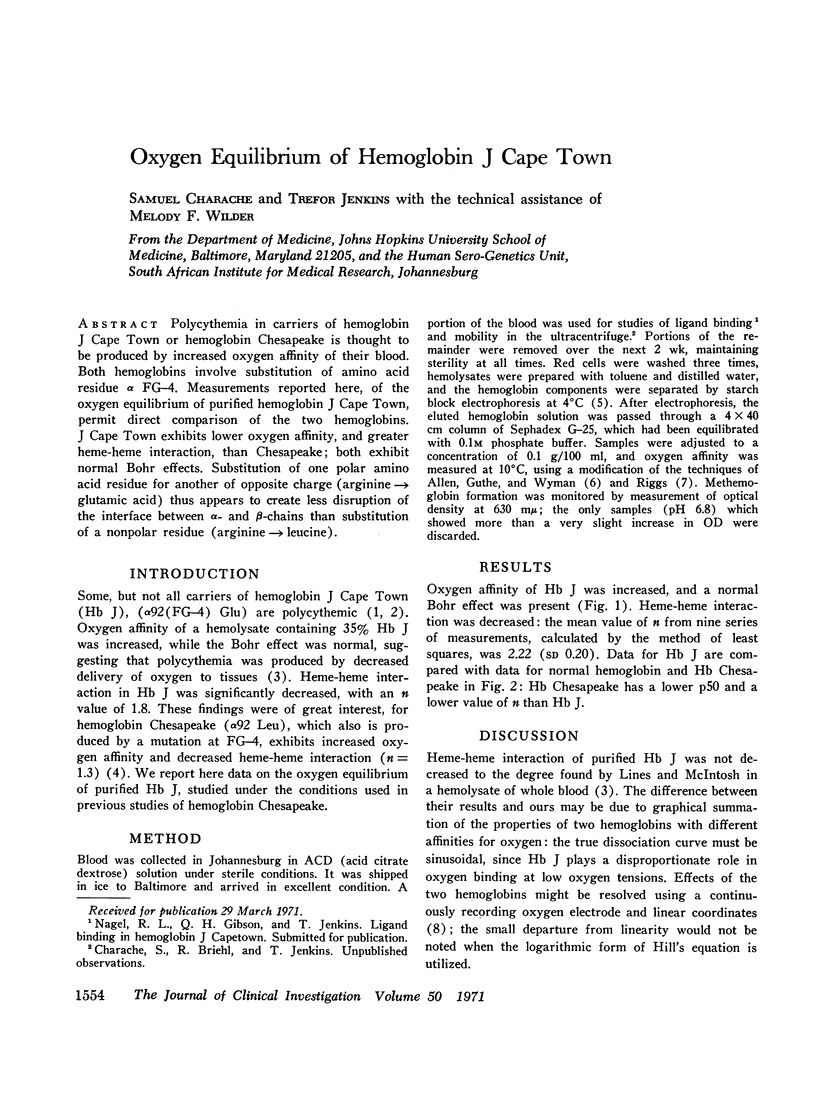Abstract
Polycythemia in carriers of hemoglobin J Cape Town or hemoglobin Chesapeake is thought to be produced by increased oxygen affinity of their blood. Both hemoglobins involve substitution of amino acid residue α FG-4. Measurements reported here, of the oxygen equilibrium of purified hemoglobin J Cape Town, permit direct comparison of the two hemoglobins. J Cape Town exhibits lower oxygen affinity, and greater heme-heme interaction, than Chesapeake; both exhibit normal Bohr effects. Substitution of one polar amino acid residue for another of opposite charge (arginine → glutamic acid) thus appears to create less disruption of the interface between α- and β-chains than substitution of a nonpolar residue (arginine → leucine).
Full text
PDF

Selected References
These references are in PubMed. This may not be the complete list of references from this article.
- ALLEN D. W., GUTHE K. F., WYMAN J., Jr Further studies on the oxygen equilibrium of hemoglobin. J Biol Chem. 1950 Nov;187(1):393–410. [PubMed] [Google Scholar]
- Baldassare J. J., Charache S., Jones R. T., Ho C. Electron paramagnetic resonance studies of spin-labeled hemoglobins. II. Roles of subunit interactions and of intermediate structures in the cooperative oxygenation of hemoglobin and the results of hemoglobin Yakima, hemoglobin J capetown, and carboxypeptidases A and B treated hemoglobin A. Biochemistry. 1970 Nov 24;9(24):4707–4713. doi: 10.1021/bi00826a013. [DOI] [PubMed] [Google Scholar]
- Botha M. C., Beale D., Isaacs W. A., Lehmann H. Hemoglobin J Cape Town-alpha-2 92 arginine replaced by glutamine beta-2. Nature. 1966 Nov 19;212(5064):792–795. doi: 10.1038/212792a0. [DOI] [PubMed] [Google Scholar]
- Charache S., Weatherall D. J., Clegg J. B. Polycythemia associated with a hemoglobinopathy. J Clin Invest. 1966 Jun;45(6):813–822. doi: 10.1172/JCI105397. [DOI] [PMC free article] [PubMed] [Google Scholar]
- Duvelleroy M. A., Buckles R. G., Rosenkaimer S., Tung C., Laver M. B. An oxyhemoglobin dissociation analyzer. J Appl Physiol. 1970 Feb;28(2):227–233. doi: 10.1152/jappl.1970.28.2.227. [DOI] [PubMed] [Google Scholar]
- Jenkins T., Stevens K., Gallo E., Lehmann H. A second family possessing haemoglobin J alpha Cape Town. S Afr Med J. 1968 Nov 2;42(42):1151–1154. [PubMed] [Google Scholar]
- KUNKEL H. G., CEPPELLINI R., MULLER-EBERHARD U., WOLF J. Observations on the minor basic hemoglobin component in the blood of normal individuals and patients with thalassemia. J Clin Invest. 1957 Nov;36(11):1615–1625. doi: 10.1172/JCI103561. [DOI] [PMC free article] [PubMed] [Google Scholar]
- Nagel R. L., Gibson Q. H., Charache S. Relation between structure and function in Hemoglobin Chesapeake. Biochemistry. 1967 Aug;6(8):2395–2402. doi: 10.1021/bi00860a015. [DOI] [PubMed] [Google Scholar]
- Perutz M. F. Stereochemistry of cooperative effects in haemoglobin. Nature. 1970 Nov 21;228(5273):726–739. doi: 10.1038/228726a0. [DOI] [PubMed] [Google Scholar]
- RIGGS A. The metamorphosis of hemoglobin in the bullfrog. J Gen Physiol. 1951 Sep;35(1):23–40. doi: 10.1085/jgp.35.1.23. [DOI] [PMC free article] [PubMed] [Google Scholar]


